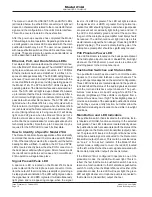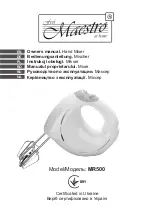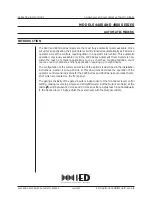
Issue Preliminary 1, October 2022
Model 214A User Guide
Page 18
Studio Technologies, Inc.
Model 214A
ANNOUNCER’S CONSOLE
The manner in which the LINK/ACT, SYS, and SYNC LEDs
(all located below the etherCON connector) will light will
depend on characteristics related to the connected Ethernet
signal and the configuration of the unit’s Dante interface.
This will be covered in detail in the next section.
After the power-up sequence has completed the Model
214A will begin normal operation. Depending on the select-
ed configuration one status LED associated with the main
pushbutton switch may be lit. The user is now presented
with two pushbutton switches, three LEDs, and three rotary
controls. These are simple to operate and understand, as
will be described in later sections.
Ethernet, PoE, and Dante Status LEDs
Four status LEDs are located below the etherCON connec-
tor on the Model 214A’s back panel. The LINK/ACT LED will
light green whenever an active connection to a 100 Mb/s
Ethernet network has been established. It will flash in re
-
sponse to data packet activity. The PoE LED will light green
whenever Power-over-Ethernet (PoE) associated with the
connected Ethernet signal is providing operating power to
the Model 214A. The SYS and SYNC LEDs display the
operating status of the Dante interface and associated net-
work. The SYS LED will light red upon Model 214A power
up to indicate that the Dante interface is not ready. After a
short interval it will light green to indicate that it is ready to
pass data with another Dante device. The SYNC LED will
light red when the Model 214A is not synchronized with a
Dante network. It will light solid green when the Model 214A
is synchronized with a Dante network and an external clock
source (timing reference) is being received. It will slowly
light on and off green when the Model 214A is part of a
Dante network and is serving as the Leader clock. (This
will not be the normal situation for most applications but is
technically possible.) Note that up to 30 seconds may be
required for the SYNC LED to reach its final state.
How to Identify a Specific Model 214A
The Dante Controller software application offers an identify
command that can be used to help locate a specific Model
214A. When Identify is selected for a specific unit the button
backlight LEDs will flash. In addition, the SYS and SYNC
LEDs, located directly below the etherCON connector on
the back panel, will slowly flash green. After a few seconds
the identification patterns will cease and normal Model
214A operation will again take place.
Signal Present/Peak LED
A dual-color LED is located on the Model 214A’s back
panel, adjacent to the microphone input connector. It mon-
itors the output of the microphone preamplifier, providing a
3-step signal level indication. The LED will light green when
the signal level is –40 dBFS or greater. It will simultaneously
light green and red, appearing orange, when the signal
level is –14 dBFS or greater. The LED will light red when
the signal level is –4 dBFS or greater. During normal op-
eration this LED should light green and when signal peaks
are present will occasionally light both green and red. If
the LED is lit constantly green and red at the same time
the gain of the microphone preamplifier most likely should
be reduced. The LED should never light red only as this
would indicate a signal that’s in danger of reaching 0 dBFS
(digital “clipping”). This would indicate that the gain of the
microphone preamplifier should be significantly reduced.
P48 Phantom Power LED
A red LED indicator is located on the back panel adjacent
to the microphone input connector. Labeled P48, it will light
whenever the P48 phantom power source is active and
providing power to the microphone input.
Pushbutton Switches and Status LEDs
Two pushbutton switches are used to control the audio
signals on the main and talkback output channels. The
way each operates depends on the selected configuration.
Three LED indicators are located adjacent to the pushbut-
tons and reflect the status of the audio signals associated
with the main and talkback output channels. The push-
buttons’ clear lenses are backlit using white LEDs. The
intensity (brightness) of these LEDs is configured from a
choice of two values, low or high. The backlighting does not
provide an indication of the associated pushbutton’s status
nor do they serve as a tally function, but rather allow the
pushbutton’s labeling and location to be visible in low-light
conditions.
Main Button and LED Indicators
The pushbutton switch that is located on the left side, facto-
ry labeled as COUGH, functions according to the selected
configuration. Two LED indicators, located directly above
the pushbutton switch, are associated with the status of the
audio signal on the Dante main transmitter (output) chan-
nel. The green LED, located on the right, is lit whenever the
microphone audio signal is connected to the Dante main
transmitter (output) channel. This could be considered as
an “on-air” or “mic-active” indicator. If the Model 214A’s
system mode is configured to on-air, the red LED, located
on the left, will be lit when the audio signal associated with
Dante main transmitter (output) channel is muted.
If the Model 214A is configured to operate in one of the
production modes, the red LED will never light. This is to
reflect the fact that the main pushbutton switch has now
taken on a function similar to that of a talkback pushbutton
switch. To clarify, when the Model 214A is set to either of the
production modes, the red LED will never light; the green
LED will light whenever microphone audio is connected to
the Dante main (transmitter) output channel.










































